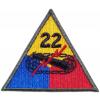81 Armored Brigade Combat Team Patch. US Army
Gadījuma:

Кокарда ВМС

AIRBORNE BERET BRIGADE BADGE. ARGENTINE ARMY

10 Sustainment Brigade Patch. US Army
Mainīt informāciju
Description
On a white square with rounded corners 2 1/4 inches (5.72cm) overall the Pacific Northwest Indian (Haida, Kwakiutl, Nootka) symbol of a raven in black, red and white all within a 1/8 inch (.32cm) red border.
Symbolism
The raven represents the fact that all units of this Brigade derive their history and background as Washington State units. The family crest of George Washington, a raven on a gold cornet, has been traditionally used to form the crest of Washington State unit insignia. The raven design is a combination of three Northwest Indian tribe designs of the raven. The head portion comes from the "Haida" Indians. The lower portion has been taken from the "Kwakiutl" Indians. The beak, eyes and mouth have been taken from the "Nootka" Indians. Most emphasis has been placed on the "Nootka" Indians as they lived on the Washington coast and the Olympic Peninsula. Both of the other tribes represented lived, for the most part, on the lower British Columbia coast and in the vicinity of Vancouver Island. The raven is one of the most common of Northwest Indian designs, but it represents one of the most unique types of design and is found only in the Pacific Northwest. The raven is considered to be of particularly good power in the legends of the Northwest Indian tribes. According to the legends this bird went into the supernatural world while the earth was still in darkness and the people could not see. The raven took the sun and escaped through a hole in the roof of the house of the "supernaturals" while they slept. Because the raven had to fly through the smoke to get out of the house, it discolored him black. While flying back to earth, with the supernaturals in chase, the parts of the sun were broken off forming the stars with the last and largest piece forming the moon. The raven then threw the sun into the sky where it gave off light and heat to the earth. The raven saved the Indians from their darkness and gave them light and a new life. The use of rectangles and squares is based on the extensive use of such shapes in Indian designs and carvings. Corners were usually rounded to tie the rectangle into the total design.
Background
The shoulder sleeve insignia was originally approved for the 81st Infantry Brigade on 27 May 1970. The insignia was redesignated for the 81st Armor Brigade with the description updated on 11 September 2003. It was redesignated for the 81st Armored Brigade Combat Team on 18 May 2007. (TIOH Drawing Number A-1-539)
On a white square with rounded corners 2 1/4 inches (5.72cm) overall the Pacific Northwest Indian (Haida, Kwakiutl, Nootka) symbol of a raven in black, red and white all within a 1/8 inch (.32cm) red border.
Symbolism
The raven represents the fact that all units of this Brigade derive their history and background as Washington State units. The family crest of George Washington, a raven on a gold cornet, has been traditionally used to form the crest of Washington State unit insignia. The raven design is a combination of three Northwest Indian tribe designs of the raven. The head portion comes from the "Haida" Indians. The lower portion has been taken from the "Kwakiutl" Indians. The beak, eyes and mouth have been taken from the "Nootka" Indians. Most emphasis has been placed on the "Nootka" Indians as they lived on the Washington coast and the Olympic Peninsula. Both of the other tribes represented lived, for the most part, on the lower British Columbia coast and in the vicinity of Vancouver Island. The raven is one of the most common of Northwest Indian designs, but it represents one of the most unique types of design and is found only in the Pacific Northwest. The raven is considered to be of particularly good power in the legends of the Northwest Indian tribes. According to the legends this bird went into the supernatural world while the earth was still in darkness and the people could not see. The raven took the sun and escaped through a hole in the roof of the house of the "supernaturals" while they slept. Because the raven had to fly through the smoke to get out of the house, it discolored him black. While flying back to earth, with the supernaturals in chase, the parts of the sun were broken off forming the stars with the last and largest piece forming the moon. The raven then threw the sun into the sky where it gave off light and heat to the earth. The raven saved the Indians from their darkness and gave them light and a new life. The use of rectangles and squares is based on the extensive use of such shapes in Indian designs and carvings. Corners were usually rounded to tie the rectangle into the total design.
Background
The shoulder sleeve insignia was originally approved for the 81st Infantry Brigade on 27 May 1970. The insignia was redesignated for the 81st Armor Brigade with the description updated on 11 September 2003. It was redesignated for the 81st Armored Brigade Combat Team on 18 May 2007. (TIOH Drawing Number A-1-539)
Citas kategorijas: Bruņas
 20 Armored Division Patch. US Army
20 Armored Division Patch. US Army
 22 Armored Division Patch. US Army
22 Armored Division Patch. US Army
 Нарукавный знак 27-й бронетанковой дивизии СВ США.
Нарукавный знак 27-й бронетанковой дивизии СВ США.
 11 Armored Division Patch. US Army
11 Armored Division Patch. US Army
 163 Armored Brigade Patch. US Army
163 Armored Brigade Patch. US Army



